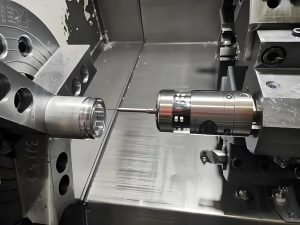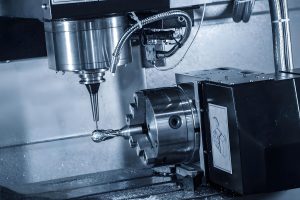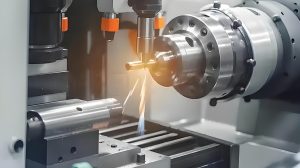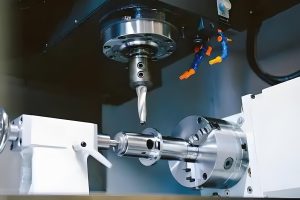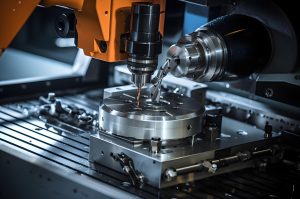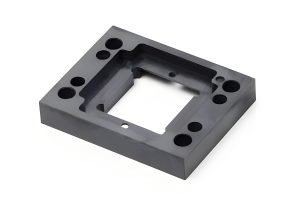Introduction
The Rise of CNC Machining Centers
In the dynamic landscape of modern manufacturing, Rapidefficient CNC Machining Centers have emerged as game – changers. These sophisticated machines have become the cornerstone of various industries, from aerospace and automotive to medical device manufacturing and electronics. Their ability to produce complex parts with high precision and efficiency has revolutionized the production process.
In the aerospace industry, for example, where components need to be lightweight yet incredibly strong, CNC machining centers are used to craft intricate parts for aircraft engines and airframes. In the automotive sector, they play a crucial role in manufacturing engine blocks, transmission components, and precision – machined parts for high – performance vehicles. As manufacturing demands continue to grow for products that are not only high – quality but also produced at a faster pace, understanding how to boost production with CNC centers becomes essential. This article will delve deep into the world of CNC machining centers, exploring their capabilities, and how to optimize them for maximum productivity.
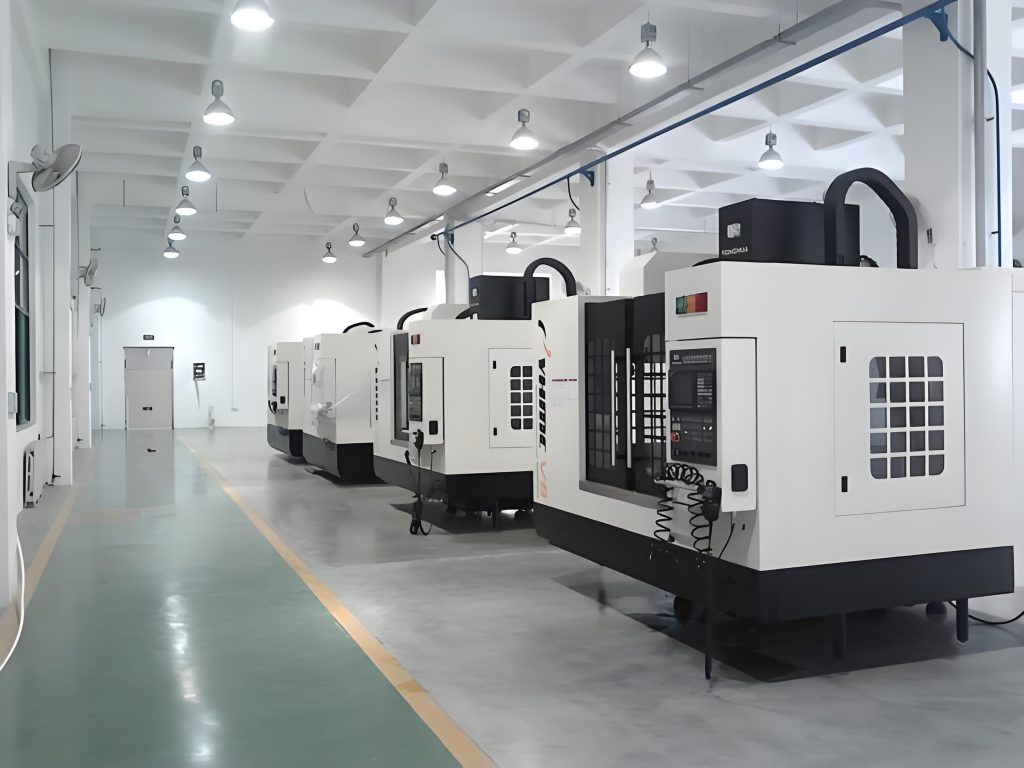
Definition and Basics of CNC Machining Center
A CNC (Computer Numerical Control) machining center is an advanced machine tool that combines the functions of multiple traditional machining tools. It is a highly automated piece of equipment that can perform various machining operations such as milling, drilling, boring, and tapping. At its core, a CNC machining center consists of a computer – controlled system that interprets programmed instructions to precisely control the movement of the machine’s axes and the operation of its tools.
The basic working principle of a CNC machining center involves the use of G – codes and M – codes. G – codes are geometric codes that control the movement of the machine’s axes, determining the path of the cutting tool. For example, a G01 code is used for linear interpolation, which moves the tool in a straight line between two points. M – codes, on the other hand, are auxiliary codes that control functions such as spindle rotation, coolant flow, and tool changes. For instance, an M03 code is used to start the spindle in a clockwise direction.
Before a machining operation begins, a CAD (Computer – Aided Design) model of the part to be produced is created. This 3D model is then converted into a CAM (Computer – Aided Manufacturing) program. The CAM software takes the design data and generates the necessary CNC code, which contains all the instructions for the machining center to execute the operations required to produce the part. Once the code is loaded into the CNC system of the machining center, the machine can start the production process automatically, accurately following the programmed instructions to create the desired part.
The Efficiency and Speed of CNC Machining Centers
Rapidefficient – A Key Aspect in CNC Machining
In the realm of CNC machining, rapidefficient stands as a crucial factor that significantly impacts the overall production process. Rapidefficient, in the context of CNC machining, encompasses the ability to achieve high – speed operations without sacrificing precision. This combination of speed and accuracy is what sets modern CNC machining centers apart from traditional machining methods.
One of the primary ways rapidefficient manifests in CNC machining is through reduced processing times. With advanced control systems and high – speed spindles, CNC machining centers can execute machining operations at much faster rates than manual or semi – automated machines. For example, a high – speed CNC milling machine can rapidly remove material from a workpiece, reducing the time required for rough machining. This not only speeds up the production of individual parts but also allows for a higher volume of parts to be produced within a given time frame.
Moreover, rapidefficient in CNC machining is also related to the quick changeover of tools. Many modern CNC machining centers are equipped with automatic tool changers (ATCs). These ATCs can swap tools in a matter of seconds, minimizing the downtime between different machining operations. In a multi – operation process, such as milling, drilling, and tapping on the same workpiece, the ability to change tools rapidly ensures a seamless transition between operations, maintaining the momentum of production.
In addition, the optimization of cutting parameters is another aspect of rapidefficient. CNC systems can precisely control variables like spindle speed, feed rate, and depth of cut. By fine – tuning these parameters based on the material being processed and the specific requirements of the part, manufacturers can achieve maximum material removal rates while ensuring the quality of the machined surface. For instance, when machining aluminum, which has different cutting characteristics compared to steel, the CNC system can adjust the cutting parameters to enable fast and efficient machining, resulting in smooth surfaces and accurate dimensions.
Case Studies of Efficiency Improvement
Numerous real – world case studies demonstrate the remarkable efficiency improvements brought about by CNC machining centers.
Case 1: Automotive Component Manufacturer
A well – known automotive component manufacturer was facing challenges in meeting the growing demands for engine cylinder heads. Their previous production method, which relied on traditional machining techniques, was slow and had a high defect rate. After investing in a state – of – the – art CNC machining center, the company witnessed a significant transformation.
The CNC machining center was capable of performing multiple operations on the cylinder heads in one setup. It could mill the surfaces, drill holes for coolant passages, and tap threads with high precision. The high – speed spindle of the CNC machine allowed for faster cutting speeds, reducing the machining time per cylinder head from 8 hours to just 3 hours. This not only increased their daily production capacity from 10 to 25 cylinder heads but also improved the quality of the parts. The defect rate dropped from 10% to less than 2%, resulting in significant cost savings due to reduced rework and waste.
Case 2: Aerospace Parts Supplier
An aerospace parts supplier was tasked with manufacturing complex turbine blades for aircraft engines. These blades required extremely high precision and tight tolerances. Before adopting CNC machining, the production process was labor – intensive and time – consuming, involving multiple manual operations and inspections.
With the introduction of a five – axis CNC machining center, the company was able to streamline the production process. The five – axis capabilities of the machine enabled it to access all sides of the turbine blade from a single setup, eliminating the need for multiple re – fixturings. This not only saved time but also improved the accuracy of the parts. The machining time for each turbine blade was reduced by 60%, from 15 hours to 6 hours. The supplier could then increase their production volume to meet the demands of the aerospace industry, while also maintaining the high – quality standards required for aircraft components.
Precision and Quality in CNC Machining
High – Precision Machining with CNC
CNC machining centers are renowned for their ability to achieve extremely high precision in machining operations. In the manufacturing of intricate components, precision is non – negotiable. For example, in the production of medical implants, such as hip joints or dental implants, the tolerance requirements are often within a few micrometers. CNC machining centers can consistently meet these tight tolerances.
The multi – axis capabilities of CNC machining centers play a crucial role in high – precision machining. A five – axis CNC machining center, for instance, allows for simultaneous movement along five different axes (X, Y, Z, A, and B). This enables the machine to access complex geometries from multiple angles without the need for re – fixturing the workpiece. When manufacturing a turbine blade for a jet engine, the five – axis CNC machine can precisely carve the complex airfoil shape, ensuring that the blade meets the exact aerodynamic requirements. The high – precision positioning of the axes, which can be controlled down to nanometer – level increments in some advanced CNC systems, guarantees that each blade produced is identical in shape and dimensions.
Moreover, the use of high – quality spindles and drives in CNC machining centers contributes to their precision. High – speed spindles can rotate at speeds of up to 100,000 RPM or more, providing the necessary cutting force and speed while maintaining stability. The drives, which control the movement of the axes, are equipped with advanced servo – control systems. These servo – control systems constantly monitor and adjust the position of the axes based on feedback from sensors, compensating for any potential errors caused by factors such as thermal expansion, mechanical wear, or external vibrations. This closed – loop control system ensures that the machining process remains accurate throughout the production run.
Quality Assurance in CNC Machining
Ensuring product quality is a top priority in any manufacturing process, and CNC machining centers offer several features and processes that contribute to consistent and high – quality output.
First and foremost, the automation of the machining process in CNC machining centers reduces the potential for human error. Since the machine operates based on pre – programmed instructions, there is less variability in the machining operations compared to manual machining. For example, in a manual milling operation, the operator’s hand – eye coordination and fatigue levels can affect the accuracy of the cut. In a CNC milling process, the machine will execute the same milling operation with the same precision over and over again, as long as the program and the machine are functioning properly.
CNC machining centers also often come equipped with in – process monitoring systems. These systems use sensors to monitor various parameters during the machining process, such as cutting force, spindle vibration, and tool wear. If any of these parameters deviate from the normal range, the system can either alert the operator or automatically adjust the machining parameters to correct the issue. For example, if the cutting force exceeds a certain threshold, it could indicate that the tool is dull or that there is a problem with the workpiece setup. The in – process monitoring system can then reduce the feed rate or increase the spindle speed to compensate for the higher cutting force, ensuring that the quality of the machined surface is not compromised.
In addition, post – processing inspection is an important part of the quality assurance process in CNC machining. High – precision measuring instruments, such as coordinate measuring machines (CMMs), are often used to check the dimensions and surface finish of the machined parts. CMMs can accurately measure the position of points on the part’s surface, comparing them to the original design specifications. If any discrepancies are found, the machining process can be adjusted for subsequent parts. This combination of in – process monitoring and post – processing inspection ensures that the products manufactured using CNC machining centers meet the highest quality standards.
Cost – effectiveness of CNC Machining Centers
Initial Investment vs Long – term Benefits
The initial investment in a CNC machining center can be substantial. High – end CNC machines, especially those with advanced features such as multi – axis capabilities, high – speed spindles, and large work envelopes, can cost hundreds of thousands of dollars or even more. Additionally, there are costs associated with the installation, training of operators, and the purchase of CAD/CAM software. For small – to – medium – sized enterprises (SMEs), this upfront cost can seem like a significant barrier.
However, when considering the long – term benefits, the investment in a CNC machining center becomes highly justifiable. Firstly, the increased productivity of CNC machining centers leads to higher output levels. As mentioned earlier, the rapidefficient nature of these machines allows for faster production times. With higher production volumes, companies can spread their fixed costs, such as the cost of the machine, over a larger number of units. This results in a lower cost per unit produced.
Secondly, CNC machining centers can reduce labor costs in the long run. Although there is a need for skilled operators to program and monitor the machines, the level of manual labor required for each part is significantly reduced compared to traditional machining methods. Fewer workers are needed to produce the same quantity of parts, which cuts down on labor – related expenses such as salaries, benefits, and training costs for a large workforce.
Moreover, the high – precision and quality output of CNC machining centers can lead to increased revenue. High – quality parts are more likely to meet or exceed customer expectations, which can result in higher customer satisfaction and repeat business. In some industries, such as aerospace and medical, high – quality components can command premium prices, further increasing the profitability of the business.
Reducing Waste and Saving Resources
One of the significant cost – saving aspects of CNC machining centers is their ability to reduce material waste. In traditional machining, manual operations and less precise tools often lead to over – cutting or incorrect cuts, resulting in wasted materials. For example, in manual milling, an operator may accidentally remove too much material from a workpiece, rendering it unusable.
CNC machining centers, on the other hand, operate based on precise digital instructions. The CAD/CAM software used to generate the machining programs calculates the exact amount of material to be removed, minimizing the chances of over – cutting. Additionally, the high – precision movement of the axes ensures that the cutting tool follows the programmed path accurately, reducing the margin of error. When machining complex parts with multiple features, a CNC machining center can precisely mill, drill, and bore the necessary holes and shapes, leaving minimal excess material.
Furthermore, CNC machining centers can optimize the use of materials through intelligent nesting algorithms. When cutting multiple parts from a single sheet or block of material, the software can arrange the parts in a way that maximizes the use of the available material. For instance, in sheet metal cutting, the software can fit irregular – shaped parts together like a puzzle, reducing the amount of scrap material. This not only saves on the cost of raw materials but also contributes to environmental sustainability by reducing waste.
In terms of energy consumption, modern CNC machining centers are designed to be energy – efficient. They often have features such as variable – speed drives for the spindles and axes, which adjust the power consumption based on the machining requirements. When the machine is performing light – duty operations, the spindle speed can be reduced, consuming less energy. Some CNC machines also have standby modes that reduce power consumption when the machine is not actively machining, further saving on energy costs over time.
Applications of CNC Machining Centers
In the Automotive Industry
In the automotive industry, CNC machining centers play a pivotal role in the production of high – performance and reliable vehicles. One of the most prominent applications is in the machining of engine components. Engine blocks, for example, are complex structures with numerous cavities, holes, and surfaces that require precise machining. CNC machining centers can accurately mill the cylinder bores to the exact dimensions required for the pistons to fit snugly. The tight tolerances ensure efficient combustion and optimal engine performance. A small deviation in the diameter of the cylinder bores could lead to issues such as piston slap, reduced power output, and increased fuel consumption.
Transmission components also rely heavily on CNC machining. Gears, shafts, and clutch housings need to be machined with high precision to ensure smooth power transfer and long – lasting durability. CNC machining centers can create the complex tooth profiles of gears with extreme accuracy, reducing noise and wear during operation. Additionally, the ability to produce parts in high volumes with consistent quality is crucial in the automotive industry. With the high demand for cars, CNC machining centers can meet the production targets while maintaining the required quality standards.
In the Aerospace Industry
The aerospace industry has some of the most stringent requirements when it comes to component manufacturing, and CNC machining centers are indispensable. Aircraft engines are a prime example of where CNC machining centers are used extensively. Turbine blades, which are subjected to extreme temperatures and high rotational forces, must be manufactured with utmost precision. CNC machining centers, especially those with multi – axis capabilities, can create the complex airfoil shapes of turbine blades. The five – axis or even six – axis CNC machines can access all sides of the blade from a single setup, ensuring that the blade’s surface finish and dimensional accuracy meet the strict aerospace standards.
In the construction of the airframe, CNC machining centers are used to produce structural components such as wing spars and fuselage frames. These components need to be lightweight yet extremely strong to withstand the stresses of flight. CNC machining allows for the precise removal of material in a strategic manner, creating parts with optimized strength – to – weight ratios. For instance, by using advanced CAD/CAM software, designers can identify areas where material can be safely removed without sacrificing structural integrity, and the CNC machining center can then accurately execute the machining operations to create the final part.
Other Industries
In the electronics industry, CNC machining centers are used to manufacture components for high – tech devices. Printed circuit board (PCB) fixtures, which hold PCBs during the manufacturing and testing processes, are often made using CNC machining. These fixtures require precise holes and cutouts to ensure a perfect fit for the PCBs. CNC machining centers can also produce heat sinks for electronic components. Heat sinks need to have a specific shape and surface area to efficiently dissipate heat. The high – precision machining capabilities of CNC machines enable the production of heat sinks with complex fins and shapes that maximize heat transfer.
In the medical industry, CNC machining centers are involved in the production of a wide range of devices. Surgical instruments, such as forceps, scalpels, and drill bits, are made with high – precision CNC machining to ensure sharp edges, smooth surfaces, and accurate dimensions. This is crucial for the safety and effectiveness of surgical procedures. Additionally, in the production of prosthetics and orthopedic implants, CNC machining centers are used to create custom – fit devices. For example, hip and knee implants can be designed based on the patient’s specific anatomy using 3D scanning technology. The design data is then used to program a CNC machining center to produce the implant with the exact shape and dimensions required for a proper fit and long – term functionality.
Choosing the Right CNC Machining Center
Key Factors to Consider
When selecting a CNC machining center, several key factors need to be taken into account.
Precision: Precision is perhaps the most critical factor. The ability of the CNC machining center to produce parts within tight tolerances is essential, especially for industries such as aerospace and medical. Look for machines with high – resolution encoders on their axes, which can provide accurate feedback on the position of the cutting tool. A machine with a positioning accuracy of ±0.001mm or better is highly desirable for precision – demanding applications.
Power and Spindle Speed: The power of the spindle motor determines the cutting force the machine can generate. For machining tough materials like hardened steel, a high – power spindle is necessary. Spindle speed also matters. High – speed spindles can enable faster machining operations, especially for materials that can tolerate high – speed cutting, such as aluminum. A spindle with a speed range from a few hundred to tens of thousands of RPM can offer versatility in different machining tasks.
Axis Configuration: The number and type of axes on a CNC machining center affect its ability to handle complex geometries. Three – axis machines are suitable for basic milling and drilling operations. However, for more complex parts, such as those with angled surfaces or intricate 3D shapes, five – axis or even multi – axis machines are required. A five – axis machine can perform operations on multiple sides of a workpiece without re – fixturing, saving time and improving accuracy.
Work Envelope: The work envelope of a CNC machining center refers to the maximum size of the workpiece it can accommodate. It is defined by the travel limits of the machine’s axes (X, Y, Z, etc.). Before purchasing a machine, consider the size of the parts you will be producing. If you plan to machine large components, such as engine blocks for trucks, you will need a machine with a large work envelope.
Tooling and Tool Changer: The availability of a wide range of compatible tools and an efficient tool – changing system is important. An automatic tool changer (ATC) with a large tool capacity can reduce the time spent on tool changes, especially for multi – operation jobs. Some ATCs can hold dozens or even hundreds of tools, allowing for continuous machining without frequent interruptions for tool replacement.
Brand and Reputation: Choosing a reputable brand is often a wise decision. Well – known brands usually have a long – standing reputation for quality, reliability, and after – sales service. Brands like Haas, Mazak, and DMG MORI are recognized globally for their high – quality CNC machining centers. Reading reviews from other users, industry reports, and visiting trade shows can help you gauge the reputation of different brands.
Budget Considerations
Budget is a significant factor when choosing a CNC machining center.
Low – Budget Options: For small – scale manufacturers or those just starting out, there are more affordable CNC machining centers available. These machines may have basic features, such as a three – axis configuration and a relatively lower spindle power. However, they can still be suitable for simple machining tasks, like producing small – scale prototypes or basic components for hobbyist projects. Some entry – level CNC mills can be found in the price range of a few thousand dollars. While they may not offer the same level of precision and speed as high – end machines, they can provide a cost – effective way to get started with CNC machining.
Mid – Range Budget: With a mid – range budget, you can expect to get a more feature – rich CNC machining center. These machines may have higher – quality components, such as better – quality spindles and servo – motors, which can result in improved precision and performance. They may also come with additional features like a larger work envelope, a more advanced control system, and a small – to – medium – sized automatic tool changer. Mid – range CNC machining centers can cost anywhere from tens of thousands to a few hundred thousand dollars, depending on the specific features and brand.
High – Budget Investments: For large – scale manufacturers or those in industries with strict precision and production requirements, high – end CNC machining centers are the way to go. These machines often have multi – axis capabilities, high – speed spindles with extreme precision, and advanced in – process monitoring systems. They can handle large – scale production runs with high efficiency and produce parts with the tightest tolerances. High – end CNC machining centers can cost upwards of half a million dollars or more, but they offer unrivaled performance and productivity, making them a worthwhile investment for companies with high – volume production needs. It’s important to note that when considering the budget, also factor in the long – term costs, such as maintenance, tooling, and software upgrades, to ensure a comprehensive understanding of the total cost of ownership.
Recommended CNC Aluminum Processing Service Provider – Rapidefficient
Introduction to Rapidefficient
Rapidefficient is a leading CNC aluminum processing service provider that has been making waves in the manufacturing industry. With a strong commitment to quality and customer satisfaction, Rapidefficient has built a solid reputation for delivering high – quality aluminum – machined parts in a timely manner. The company is equipped with state – of – the – art facilities and staffed by a team of highly skilled professionals who are passionate about CNC machining.
Services Offered by Rapidefficient
Rapidefficient offers a comprehensive range of aluminum processing services. One of their core services is CNC milling of aluminum. They can create complex 2D and 3D shapes with high precision. Whether it’s a simple aluminum plate with milled grooves or a highly intricate aerospace – grade aluminum component with multiple cavities and features, Rapidefficient’s CNC milling capabilities can handle it. For example, they can mill aluminum parts with tight tolerances of up to ±0.05mm, ensuring that the parts fit perfectly into the final product assembly.
CNC turning of aluminum is another service they excel in. They can produce cylindrical aluminum parts with smooth surfaces and accurate dimensions. From small aluminum shafts for electronic devices to larger shafts for automotive applications, Rapidefficient’s turning operations are carried out with utmost precision. The company also offers aluminum drilling and tapping services. They can create holes of various sizes and thread them accurately, which is crucial for assembling aluminum components with screws or bolts.
In addition, Rapidefficient provides aluminum surface finishing services. This includes processes like anodizing, which not only enhances the appearance of the aluminum parts but also improves their corrosion resistance. They can also perform polishing to achieve a mirror – like finish on aluminum surfaces, making the parts suitable for applications where aesthetics matter, such as in consumer electronics or high – end automotive interiors.
Why Choose Rapidefficient
There are several compelling reasons to choose Rapidefficient for your CNC aluminum processing needs. Firstly, they have extensive experience in the field. With years of working with aluminum materials and CNC machining technology, they have gained in – depth knowledge of the best practices for processing aluminum. This experience allows them to anticipate and solve any potential issues during the machining process, ensuring a smooth production flow.
Secondly, Rapidefficient invests heavily in advanced technology. Their CNC machines are equipped with the latest features, such as high – speed spindles and multi – axis capabilities. These advanced machines enable them to achieve high – speed and high – precision machining, resulting in faster production times and better – quality parts. For example, their high – speed spindles can rotate at speeds of up to 20,000 RPM, allowing for rapid material removal when machining aluminum.
Moreover, Rapidefficient has a strict quality control system in place. They conduct thorough inspections at every stage of the production process, from the initial raw material inspection to the final product inspection. This ensures that every aluminum part leaving their facility meets the highest quality standards. They also use advanced measuring equipment, such as coordinate measuring machines (CMMs), to verify the dimensions of the parts accurately.
In terms of customer service, Rapidefficient stands out. They work closely with their clients from the initial design stage to the final delivery. Their team of experts can provide valuable advice on design optimization to make the parts more manufacturable and cost – effective. They also offer fast turnaround times, ensuring that your projects are completed on schedule. Whether you need a small batch of prototype parts or a large – scale production run, Rapidefficient can meet your requirements with professionalism and efficiency.
In conclusion, if you are looking for a reliable and high – quality CNC aluminum processing service provider, Rapidefficient is an excellent choice. Their combination of experience, advanced technology, strict quality control, and outstanding customer service makes them a top player in the CNC machining industry.
Conclusion
Recap of the Benefits of CNC Machining Centers
In summary, CNC machining centers offer a plethora of benefits that have transformed the manufacturing landscape. Their rapidefficient nature is a game – changer, enabling manufacturers to achieve high – speed production without sacrificing precision. The ability to execute machining operations at a faster pace, combined with quick tool changes and optimized cutting parameters, results in significantly reduced processing times and increased productivity.
The high – precision capabilities of CNC machining centers are equally remarkable. With multi – axis movement and advanced control systems, they can produce parts with tight tolerances, meeting the strict requirements of industries such as aerospace, medical, and electronics. This precision not only ensures the quality of the final products but also reduces the need for rework, saving both time and resources.
Cost – effectiveness is another major advantage. Although the initial investment may be high, the long – term benefits, including increased productivity, reduced labor costs, and minimized material waste, make CNC machining centers a smart investment. They can optimize the use of materials, reduce energy consumption, and contribute to overall cost savings in the manufacturing process.
The Future of CNC Machining
Looking ahead, the future of CNC machining is bright and full of potential. As technology continues to advance, CNC machining centers will become even more intelligent and efficient. The integration of artificial intelligence (AI) and the Internet of Things (IoT) into CNC systems is on the horizon. AI – powered algorithms will be able to analyze real – time machining data, such as cutting forces, tool wear, and temperature, and automatically adjust the machining parameters to optimize the process. This will lead to even higher – quality parts, reduced tool breakage, and increased machine uptime.
The development of 5G technology will also have a profound impact on CNC machining. With 5G’s high – speed and low – latency capabilities, remote monitoring and control of CNC machining centers will become more seamless. Manufacturers will be able to access and manage their machining operations from anywhere in the world, enabling real – time decision – making and faster response times to any issues that may arise.
In addition, the trend towards Industry 4.0 will drive the further integration of CNC machining centers into smart factories. They will be an integral part of a connected manufacturing ecosystem, communicating with other machines, robots, and management systems. This will enable greater automation, improved supply chain management, and enhanced overall production efficiency.
In conclusion, CNC machining centers are here to stay, and their importance in the manufacturing industry will only continue to grow. Whether you are a small – scale manufacturer looking to improve your production capabilities or a large – scale enterprise aiming to stay at the forefront of innovation, understanding and leveraging the power of CNC machining centers is essential. And when it comes to CNC aluminum processing, Rapidefficient stands out as a reliable partner, offering top – notch services, advanced technology, and a commitment to quality and customer satisfaction.

